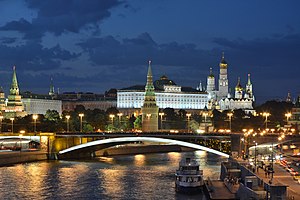Great stone bridge
Coordinates: 55 ° 44 ′ 49 ″ N , 37 ° 36 ′ 44 ″ E
| Great stone bridge | ||
|---|---|---|
| Today's bridge | ||
| Official name | Большо́й Ка́менный мост | |
| use | Road traffic | |
| Subjugated | Moskva | |
| place | Moscow | |
| construction | Arch Bridge from steel | |
| overall length | 487 m | |
| width | 40 m | |
| Number of openings | 3 | |
| start of building | 1935 | |
| completion | 1938 | |
| planner | Architect team Wladimir Schchuko , Wladimir Helreichen and Michail Minkus | |
| location | ||
|
|
||
The Great Stone Bridge ( Russian Большо́й Ка́менный мост Bolshoi Kamenny most ) is a road bridge over the Moskva River in Moscow . It is located right next to the Moscow Kremlin . Today arch bridge of steel was completed 1938th
Predecessor structures
As early as the 15th century, the Kremlin was connected to Samoskvorechye by a floating bridge.
First bridge, 1692
In 1643 Michael I commissioned the Strasbourg architects Cristler to design a stone bridge. Shortly afterwards, the Tsar and one of the architects died and the project was interrupted. The information about the completion are contradicting; it is dated between 1687 and 1692 and is attributed to the simple monk Filaret or the politician and architecture patron Vasily Golitsyn .
Initially the bridge was called Allerheiligen-Brücke (Vsechswjatski most), but was later renamed. Its north-western end was further south than it is today, on the train of today's Lenivka Street. According to studies by Iwan Kondratjew, it was originally 11 tripods wide and spanned the river, which is up to 105 meters wide, with five arches of 40 cubits each. Two more sheets were added later. At the south end there was a bridge tower , which is considered the first stone triumphal arch in Moscow. The bridge was built with wooden commercial buildings that were demolished in 1785. She was notorious for illegal street races with troikas .
Second bridge, 1859
In 1859 a bridge with three steel arches (36, 40 and 36 meters) on stone pillars was built on the same spot.
There were no crossing-free penetrations for the riverside roads . This was a problem even before the automobile era and led to the bridge's demolition in the 1930s.
Today's bridge
An architecture competition was held for a successor building as early as 1921; none of the designs were selected. In the second competition, the first prize went to the team of architects Vladimir Schtschuko , Vladimir Helfreich and Mikhail Minkus (three of the protagonists of the "Stalin architecture" , which is also at the nearby new building of the Lenin Library a few, and later at the Moscow "Stalin skyscrapers" were involved ) and the engineer Nikolai Kalmykow. Their design was realized between 1935 and 1938.
The main field has a span of 105 meters and a height of 8.4 meters. Six parallel hollow box steel arches support the 40 meter wide roadway with eight lanes. The bearings are located on caisson foundations. The quayside roads are crossed on two 42.5 meter long approach bridges. The total length including ramps is 487 meters.
The bridge crosses the river immediately west of the Kremlin and forms a continuation of Mokhovaya and Manezhnaya Streets, which converge on the left bank just before the bridge to Borovitskaya Square. At the other end, the bridge passes the house on the embankment . The traffic reaches the garden ring via the Small Stone Bridge ( Ма́лый Ка́менный мост / Maly Kammenny most ) via the water diversion canal and further via the streets Bolschaja Polyanka or Jakimanski projesd and Bolschaja Jakimanka .
As part of the 1980 Summer Olympics , the marathon ran across the bridge.
Web links
- Great stone bridge. In: Structurae
- Bolshoi Kamenny Bridge. In: Moscow Portal International. Retrieved December 28, 2013 .
- Большой каменный мост. In: Архитектура России. Retrieved December 28, 2013 (Russian).





